In today’s highly competitive business landscape, customer experience has emerged as a key differentiator for companies across industries. As customers become more discerning and demanding, organizations need to go beyond product-centric approaches and focus on understanding and delivering exceptional experiences throughout the customer journey. One powerful tool that has gained traction in this pursuit is customer journey mapping. In this comprehensive blog, we will delve into the depths of customer journey mapping, exploring its significance, process, benefits, and best practices, with a specific focus on how it can revolutionize the banking industry.
Understanding Customer Journey Mapping
What is Customer Journey Mapping?
Customer journey mapping is the process of visualizing and understanding the steps that a customer takes when interacting with a company or brand. It involves identifying all the touchpoints that a customer has with a company, from initial awareness to post-purchase follow-up, and mapping out the customer’s experience at each stage. The goal is to gain insights into the customer’s needs, pain points, and opportunities for improvement, in order to create a better overall customer experience.
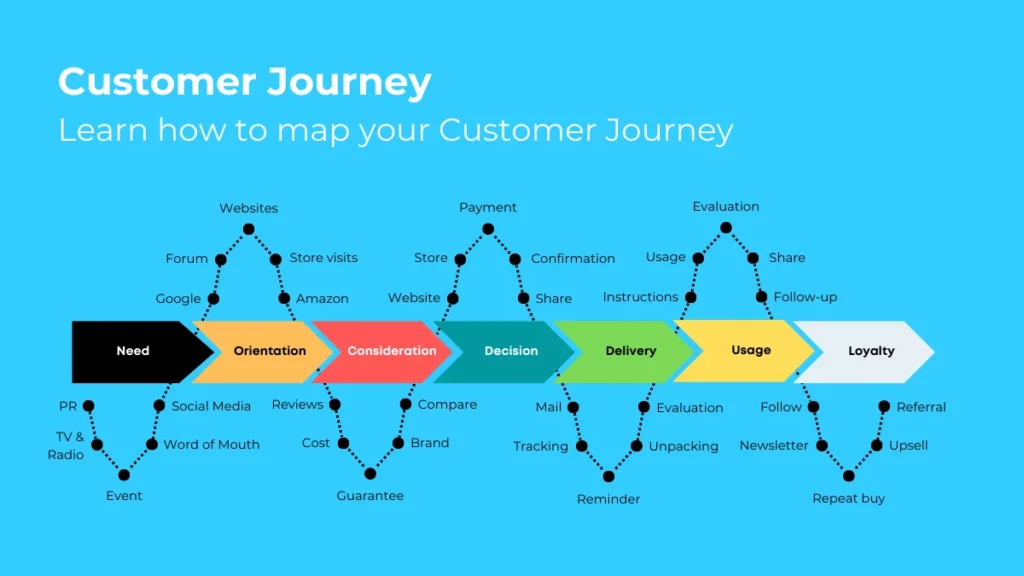
The Importance of Customer Journey Mapping in Today’s Business Landscape
Customer journey mapping involves creating a detailed map of every interaction that occurs between a customer and a brand. This includes browsing products online, speaking with customer service representatives, and more. By breaking down each touchpoint into individual steps, businesses can identify areas where customers may be experiencing frustration or confusion, and make necessary improvements to enhance the overall customer experience.
Understanding the customer experience
Customer journey mapping allows businesses to understand the entire customer experience, from initial awareness to post-purchase follow-up. This understanding can help businesses identify pain points and areas for improvement in the customer journey.
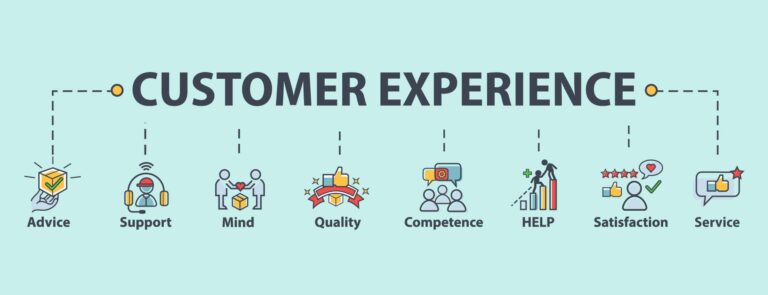
Identifying customer needs
By mapping out the customer journey, businesses can identify the needs and expectations of their customers at each stage. This information can be used to tailor marketing messages and improve the overall customer experience.
Identifying customer needs
A positive customer experience is crucial for customer satisfaction and loyalty. By identifying pain points and areas for improvement, businesses can make changes to improve the customer experience and increase customer satisfaction.
Increasing customer retention
A positive customer experience can lead to increased customer retention. By mapping out the customer journey and making improvements, businesses can increase the likelihood that customers will return for future purchases.
Increasing customer retention
A positive customer experience can also enhance a brand’s reputation. By providing a seamless and enjoyable customer journey, businesses can build a positive reputation and increase customer referrals.
Aligning internal teams
Customer journey mapping can also help align internal teams, such as marketing, sales, and customer service. By understanding the customer journey, teams can work together to provide a cohesive and consistent customer experience.
Driving business growth
A positive customer experience can lead to increased sales and business growth. By mapping out the customer journey and making improvements, businesses can attract new customers and retain existing ones, ultimately driving business growth.
Different methods of Customer Journey Mapping
Current-State Journey Mapping:
This approach focuses on understanding the customer’s current experience with the company or brand. It involves mapping out each touchpoint and interaction the customer has with the business, from the initial awareness stage to post-purchase support. The goal is to identify pain points, gaps, and areas of improvement in the existing customer journey. This approach helps businesses gain a holistic view of the customer experience and identify opportunities for enhancing customer satisfaction and loyalty.
Future-State Journey Mapping:
Future-state journey mapping involves envisioning and mapping out an ideal customer experience. It is a more aspirational approach that focuses on how the customer journey could be improved and optimized in the future. This approach allows businesses to think creatively and outside the box, identifying innovative solutions and new touchpoints that can enhance the customer experience. Future-state journey mapping helps companies set goals and create a roadmap for delivering exceptional customer experiences.
Service Blueprinting:
Service blueprinting is a comprehensive approach that goes beyond mapping the customer journey and also incorporates the internal processes and systems that support the customer experience. It involves mapping out the different layers of service delivery, including front-stage customer interactions, backstage support processes, and the underlying technology and infrastructure. Service blueprinting helps businesses understand the end-to-end service ecosystem, identify dependencies, and uncover opportunities for streamlining operations and delivering seamless customer experiences.
Emotional Journey Mapping:
This approach focuses on mapping the emotional experience of customers throughout their journey. It involves identifying and documenting the emotions customers experience at each touchpoint, from initial excitement or frustration to satisfaction or disappointment. Emotional journey mapping helps businesses understand the emotional drivers behind customer behavior and decision-making, enabling them to design experiences that evoke positive emotions and strengthen customer relationships. This approach is particularly useful for creating memorable and engaging experiences that foster customer loyalty.
The Process of Customer Journey Mapping
The process of customer journey mapping involves several steps to ensure a comprehensive and insightful understanding of the customer experience. While the specific steps may vary depending on the approach and tools used, here is a general framework for customer journey mapping:
Define the Purpose and Scope
Start by clarifying the purpose of the customer journey mapping exercise. Identify the specific objectives, such as improving customer satisfaction or identifying pain points. Determine the scope of the mapping, whether it’s for a specific product or service, a particular customer segment, or the entire customer journey.
Identify Personas
Develop customer personas that represent different customer segments or archetypes. These personas should be based on research and data, capturing key characteristics, needs, and preferences of the target audience. Personas provide a foundation for understanding the customer mindset and guiding the mapping process.

Gather Data and Insights
Collect relevant data and insights about customer behavior, preferences, and touchpoints. This can involve conducting surveys, interviews, and focus groups with customers, analyzing customer feedback and complaints, and reviewing existing customer data and analytics. The goal is to gain a deep understanding of customer motivations, pain points, and the sequence of interactions they have with the business.
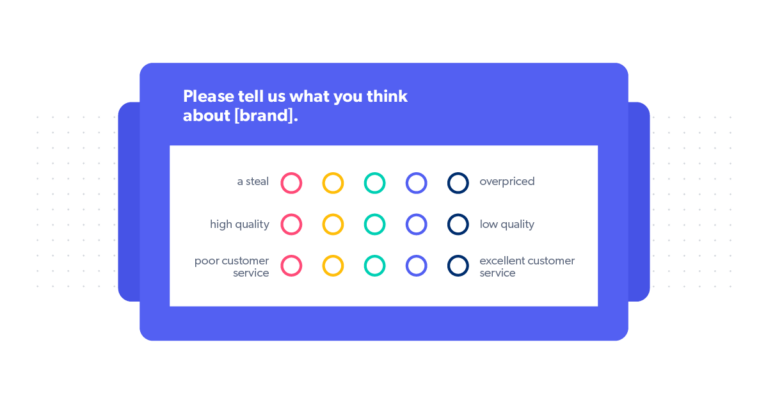
Map the Customer Journey
Visualize the customer journey by mapping out the touchpoints and interactions customers have with the business. Start from the initial awareness stage and progress through each stage of the customer lifecycle, including pre-purchase, purchase, and post-purchase. Identify all relevant touchpoints, such as website visits, social media interactions, customer service calls, and in-person interactions. Capture customer emotions, motivations, and actions at each stage.
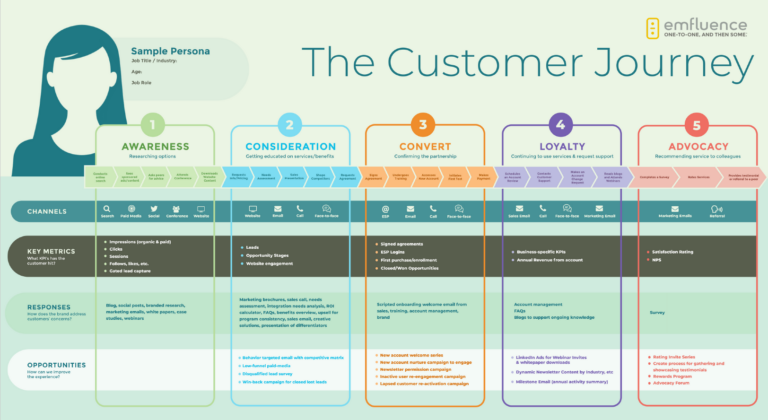
Analyze and Identify Pain Points
Analyze the customer journey map to identify pain points, bottlenecks, and areas of friction. Look for moments of customer frustration, delays, inconsistencies, or gaps in the experience. Pay attention to customer emotions and the impact of each touchpoint on their overall satisfaction. Use this analysis to identify specific areas for improvement and prioritize them based on their impact and feasibility.
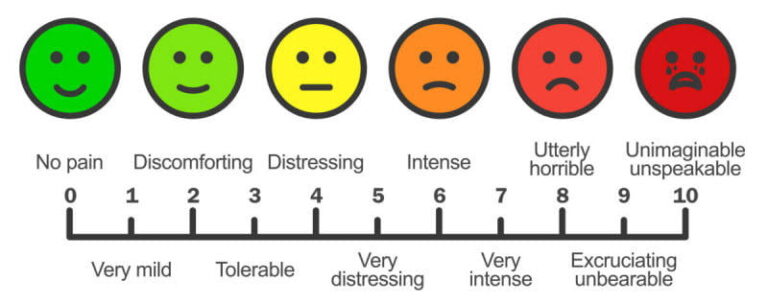
Generate Insights and Ideas
Generate insights from the customer journey map and brainstorm ideas for enhancing the customer experience. Use the identified pain points and customer feedback to identify opportunities for innovation and improvement. Consider how technology, processes, and interactions can be optimized to deliver a more seamless and satisfying experience. Encourage cross-functional collaboration to generate diverse perspectives and creative solutions.
Design and Implement Changes
Based on the insights and ideas generated, develop a plan to implement changes and improvements to the customer journey. This may involve redesigning touchpoints, streamlining processes, improving communication channels, or introducing new technologies. Consider the feasibility, cost, and potential impact of each change. Test and iterate on the proposed changes before implementing them at scale.
Monitor and Measure
Continuously monitor and measure the impact of the implemented changes on the customer experience. Collect feedback, conduct surveys, and track key performance indicators (KPIs) to assess the effectiveness of the improvements. Use this data to iterate and refine the customer journey map over time, ensuring ongoing alignment with customer needs and evolving business goals.
Remember that customer journey mapping is an iterative process that requires ongoing attention and refinement. It’s essential to regularly revisit and update the customer journey map to reflect changes in customer behavior, market dynamics, and business objectives. By staying customer-centric and continuously improving the customer experience, businesses can build strong relationships and drive long-term success.
Benefits of customer journey mapping
Enhancing Customer Understanding and Empathy
- Gather customer insights: Conduct qualitative and quantitative research to gather data on customer behaviors, preferences, and motivations. Use techniques like surveys, interviews, and observation to gain a deep understanding of their needs and expectations.
- Create customer personas: Develop detailed profiles of your target customers based on the collected data. Include information such as demographics, goals, pain points, and preferred communication channels. These personas serve as representations of your customers and help you empathize with their experiences.
- Map the current customer journey: Visualize the steps and touchpoints customers go through when interacting with your business. Identify key moments of interaction, emotions, and pain points at each stage. This mapping process provides a holistic view of the customer experience and enables you to identify areas for improvement.
Identifying Customer Pain Points and Opportunities for Improvement
- Analyze the customer journey map: Review the mapped journey to identify pain points, bottlenecks, and areas of friction. Look for moments where customers might encounter difficulties or experience negative emotions. These pain points highlight areas that need improvement.
- Collect customer feedback: Gather feedback from customers through surveys, feedback forms, or social media channels. Pay attention to complaints, suggestions, and comments about their experience with your brand. This feedback can provide valuable insights into specific pain points and areas for improvement.
- Prioritize improvements: Prioritize the identified pain points based on their impact on the customer experience and the feasibility of addressing them. Focus on areas that have the potential to make a significant positive impact on customer satisfaction and loyalty.
Optimizing Touchpoints and Channels
- Assess touchpoints and channels: Evaluate each touchpoint in the customer journey and the channels through which they are delivered. Consider factors such as ease of use, accessibility, consistency, and relevance to the customer’s needs.
- Streamline processes: Identify areas where processes can be simplified or streamlined to eliminate unnecessary steps or reduce customer effort. Look for opportunities to automate repetitive tasks or improve the speed and efficiency of interactions.
- Integrate channels: Ensure a seamless experience across different channels by integrating them effectively. Enable customers to transition smoothly between channels without losing context or encountering obstacles.
Personalizing the Customer Experience
- Leverage customer data: Utilize customer data to personalize interactions and tailor the experience to individual preferences. Use data on past purchases, browsing behavior, and demographic information to provide personalized recommendations, offers, and communication.
- Implement automation and AI: Explore the use of automation and artificial intelligence to deliver personalized experiences at scale. AI-powered systems can analyze customer data in real-time and provide personalized recommendations or assistance.
Driving Customer Engagement and Loyalty
- Foster emotional connections: Identify opportunities to create positive emotional experiences throughout the customer journey. Consider ways to surprise and delight customers, exceed their expectations, and leave a lasting impression.
- Implement loyalty programs: Develop loyalty programs that reward customers for their engagement and loyalty. Offer exclusive benefits, discounts, or personalized offers to encourage repeat purchases and ongoing engagement.
Achieving Business Growth and Competitive Advantage
- Monitor and measure performance: Continuously track key performance indicators (KPIs) related to customer experience, such as customer satisfaction scores, Net Promoter Score (NPS), customer retention rates, and revenue growth. Regularly analyze the data to identify trends and areas for improvement.
- Iterate and refine: Use the insights gathered from customer journey mapping and ongoing measurement to make iterative improvements to the customer experience. Continuously refine processes, touchpoints, and personalization efforts to stay aligned with customer needs and preferences.
- Stay ahead of competitors: By delivering exceptional customer experiences, you can differentiate your business from competitors.
Conclusion
As customer expectations continue to evolve and technology reshapes industries, customer journey mapping has emerged as an indispensable tool for businesses, including the banking sector. By adopting a customer-centric approach, banks can gain valuable insights into their customers’ needs, pain points, and expectations, allowing them to optimize touchpoints, deliver personalized experiences, and foster long-term customer loyalty. Through journey mapping, banks can transform their operations, drive innovation, and thrive in the digital age. By putting the customer at the heart of every decision, banking institutions can create a future where exceptional customer experiences are the norm rather than the exception.


